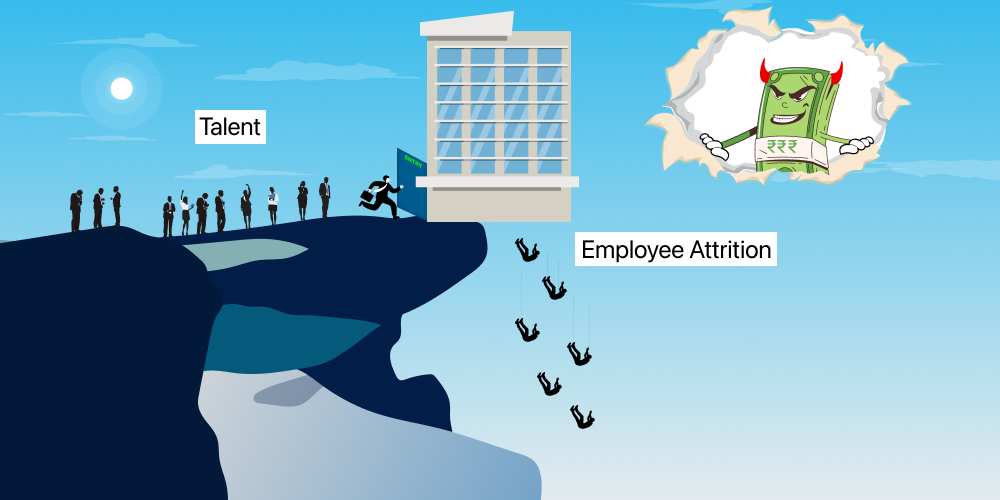The HR Recruitment Process: More Than Just Hiring People

Walk into any organisation, startup or multinational, and ask what keeps the engine running. It won’t just be tech, products, or processes. It’s people. But building that workforce isn’t about just filling seats. It’s about attracting, selecting, and nurturing the right talent, which is where a thoughtful and well-executed HR recruitment process comes into play.
And here’s the truth: recruitment isn’t just an HR function. It’s a business-critical lever that shapes everything from productivity and profitability to culture and customer experience.
We will break down what the modern HR recruitment process looks like, the human stories behind it, and how businesses can rethink hiring as a strategic advantage, not just a back-office task.
Why the HR Recruitment Process Matters
In a world of constant change, digital disruption, shifting employee expectations, and rising attrition, companies can no longer afford a transactional approach to hiring.
The HR recruitment process is evolving from being reactive (“We have a vacancy, let’s fill it”) to proactive (“What capabilities will we need in the next 12 months to meet our business goals?”). It is now a key pillar of broader HR strategy, influencing everything from employee engagement to succession planning.
Whether you’re hiring a sales associate in a retail store or a cloud architect for a tech team, the steps in recruitment must balance speed with quality, cost with long-term value, and scale with personalisation.
Key Steps in an HR Recruitment Process
Let’s walk through the recruitment journey, not just from an operational lens, but with the human element in focus.
- Workforce Planning: Start with Why
Before you write the job description or post the vacancy, step back. Ask: Why do we need this role? What will success look like in this position? How does it tie into our broader goals?Effective HR recruitment strategy begins here. It’s about anticipating needs, understanding capability gaps, and aligning talent plans with business vision.
Real-world example:
A growing E-Commerce company doesn’t just plan for more delivery executives during festive seasons; they forecast future demand, map locations, and ensure the workforce plan supports their customer experience goals. - Job Description: Telling the Right Story
The JD isn’t just a list of tasks. It’s a window into your organisation. Candidates today care about more than just salary; they’re looking for growth, values, flexibility, and purpose.HR teams and manpower agencies must craft job descriptions that appeal to both the head and the heart: responsibilities, yes, but also what the role offers in terms of learning, culture, and impact. - Sourcing Talent
Gone are the days when posting on a job board was enough. Modern recruitment combines multiple channels:
* Internal referrals
* Professional networks
* Campus hiring
* Gig platforms
* Social media (LinkedIn, Instagram, even WhatsApp)
* Collaborating with a manpower agency or third-party HR solutions providerThe focus is on building talent pools, not just finding one person for one role. - Screening & Selection: More Than Just a Resume
This is where the “human” in human resources counts.AI tools and automated tests can shortlist resumes, but cultural fit, adaptability, and team alignment still need human judgment. Great recruiters look beyond pedigree; they look for potential, attitude, and alignment with values. - Interviews: A Two-Way Street
The best candidates are evaluating you as much as you’re evaluating them. Don’t turn interviews into interrogations. Make them conversations.
* Share what the role entails, but also be transparent about challenges
* Let candidates meet team members
* Give them a sense of the culture - Offer & Onboarding: The First Impression
Offer letters aren’t just about CTCs. They’re about clarity, communication, and trust.But onboarding? That’s where retention begins.A good onboarding process doesn’t just hand out laptops and ID cards. It introduces the employee to your purpose, your people, and your processes. Companies with strong onboarding processes tend to experience better new hire retention. HR solutions, such as digital onboarding platforms, buddy programs, and feedback loops, can create a seamless and engaging experience for employees.
Rethinking Recruitment as Strategy
Many companies still view hiring as a task. Post job > receive resumes > schedule interviews > hire.
But what if we saw the HR recruitment process as a growth lever?
- What if hiring managers collaborated more closely with HR to forecast future skills needs?
- What if HR professionals upskilled in talent analytics and market mapping?
- What if we built internal talent marketplaces to reduce hiring costs?
- What if recruitment KPIs included quality of hire, not just time-to-fill?
That’s where a robust HR strategy comes in. It connects hiring to business impact. It ensures you’re not just filling gaps, but building the future.
Role of Manpower Agencies and HR Solution Providers
In fast-scaling businesses, the internal HR team can’t do it all. That’s where partnerships matter.
A manpower agency or third-party HR solution provider can bring:
- Access to wider and verified talent pools
- Domain-specific hiring expertise
- Background verification and compliance support
- Scalable recruitment models (volume hiring, seasonal hiring, gig deployment)
Conclusion
The HR recruitment process isn’t just about hiring employees. It’s about shaping culture, driving performance, and setting the stage for long-term success. Whether you’re a startup hiring your first 10 employees or a large enterprise managing 10,000, getting your recruitment strategy right is non-negotiable.
And as the war for talent intensifies, the organisations that win won’t be the ones with the biggest job boards; they’ll be the ones with the strongest HR strategy, the most human approach, and the most innovative use of HR solutions and manpower agencies.
Because in the end, hiring isn’t just a function.
Contact Us to optimise your HR recruitment process with the right strategy, tools, and partners.
Latest Blogs
The HR Recruitment Process: More Than Just Hiring People
Walk into any organisation, startup or multinational, and ask what keeps the engine running. It won’t just be tech, products, or processes. It’s people. But...
Read MoreHow Staffing Partners Transform Recruitment & Selection Process
The recruitment and selection process in HRM (Human Resource Management) has evolved significantly, and it plays a pivotal role in shaping the future of any...
Read MoreTalent Acquisition vs Recruitment in Workforce Planning
In many boardroom conversations, “talent acquisition” and “recruitment” are used interchangeably, but the reality is, they’re not the same. While both deal with bringing people...
Read MoreEvolution of Human Resource Management in India
The evolution of human resource management in India is a compelling story of how businesses have transformed their approach to people. What started as a...
Read More5 Key Manpower Supply Strategies for Hiring Better Talent
In today’s competitive job market, ensuring a reliable manpower supply is critical for business continuity and growth. Whether managing large-scale operations or expanding your business,...
Read MoreHow Staffing Partners Transform Recruitment & Selection Process

The recruitment and selection process in HRM (Human Resource Management) has evolved significantly, and it plays a pivotal role in shaping the future of any organisation. From attracting high-quality candidates to ensuring a seamless hiring process and experience, having a robust recruitment and selection process is no longer a luxury—it’s a necessity.
If you’re an HR leader, TA head, or business head trying to scale your team while hitting those aggressive growth targets, you know exactly what I’m talking about. You’re caught between needing people yesterday and ensuring you don’t compromise on quality. It’s exhausting.
Key Recruitment Process Steps
Before we dive into solutions, let’s talk about what really goes into hiring someone. The recruitment process is messier than most people realize, and the process involves many detailed steps:
To fully grasp how recruitment and selection impact organisational success, it’s important to understand the core stages. Each plays a vital role in attracting, evaluating, and onboarding the right talent. Let’s take a closer look at these key steps in the recruitment process in HRM:
- Identifying Hiring Needs – Analysing workforce gaps and defining role requirements based on business objectives and current open positions.
- Creating Job Descriptions – Crafting compelling job profiles for job postingson multiple job boards to attract the right talent while setting clear expectations.
- Sourcing Candidates – Leveraging multiple channels to build a diverse pool of qualified candidates.
- Screening & Shortlisting – Evaluating applications and resumes to identify the most suitable candidates through an applicant tracking system and conducting initial phone screenings.
- Conducting Interviews – Assessing candidate skills, cultural fit, and potential through structured interviews.
- Final Selection & Offer Rollout – Making data-driven hiring decisions and extending competitive offer letter.
- Onboarding – Integrating new hires seamlessly into the organisation for faster productivity.
A sound recruitment process in HRM ensures these steps are optimised and aligned with business goals. However, handling it in-house can overwhelm teams during rapid growth. Outsourcing to experts saves time, allowing internal teams to focus on priorities while staffing partners deliver faster, high-quality hiring through streamlined processes.
Why Partner with Recruitment Experts?
When you get recruitment right – whether in-house or with partners – something interesting happens. You stop just filling vacancies and start building teams that actually move the needle. Good recruitment becomes a competitive advantage. You’re not just hiring people; you’re building capabilities. You’re creating teams that can adapt, grow, and deliver results that matter.
Outsourcing eliminates many internal costs tied to screening, job posting, background checks, and onboarding tools, The companies that figure this out don’t just survive – they thrive. They build agile organizations that can scale up or down based on market conditions. They create cultures where people want to work and stay.
Where Do You Go From Here?
If you’re reading this and thinking, “This sounds like my life,” you’re not alone. The recruitment challenge is real, but so are the solutions.
Maybe it’s time to stop trying to do everything yourself. Maybe it’s time to find partners who can handle the heavy lifting while you focus on what you do best.
The question isn’t whether you need help with recruitment. The question is whether you’re ready to get it.
Ready to transform your hiring journey?
Let’s connect to explore how we can optimise your recruitment strategy today.
Latest Blogs
The HR Recruitment Process: More Than Just Hiring People
Walk into any organisation, startup or multinational, and ask what keeps the engine running. It won’t just be tech, products, or processes. It’s people. But...
Read MoreHow Staffing Partners Transform Recruitment & Selection Process
The recruitment and selection process in HRM (Human Resource Management) has evolved significantly, and it plays a pivotal role in shaping the future of any...
Read MoreTalent Acquisition vs Recruitment in Workforce Planning
In many boardroom conversations, “talent acquisition” and “recruitment” are used interchangeably, but the reality is, they’re not the same. While both deal with bringing people...
Read MoreEvolution of Human Resource Management in India
The evolution of human resource management in India is a compelling story of how businesses have transformed their approach to people. What started as a...
Read More5 Key Manpower Supply Strategies for Hiring Better Talent
In today’s competitive job market, ensuring a reliable manpower supply is critical for business continuity and growth. Whether managing large-scale operations or expanding your business,...
Read MoreTalent Acquisition vs Recruitment in Workforce Planning

In many boardroom conversations, “talent acquisition” and “recruitment” are used interchangeably, but the reality is, they’re not the same. While both deal with bringing people into an organisation, their approach, mindset, and long-term impact differ significantly.
As companies scale and compete for future workforce talent, understanding this difference becomes vital, especially for those leading strategic workforce plan or workforce transformation initiatives within HR departments.
Recruitment: Filling a Position
Recruitment is reactive by nature. It kicks in when a vacancy opens up, whether due to attrition, expansion, or restructuring. The goal? Fill the position quickly, cost-effectively, and with someone who meets the job description.
Think of recruitment strategies as a transaction. It focuses on the “now”, current needs, current availability, and current fit.
Example:
Talent Acquisition: Building a Talent Engine
Talent acquisition is a strategic function, focused on long-term workforce planning. It’s about anticipating future needs, building a sustainable talent pipeline with strategic planning, build relationship and aligning hiring with business goals.
Where recruitment fills seats, talent acquisition builds capability.
Example:
A manufacturing company wants to expand into EV components over the next three years. Instead of waiting for vacancies to arise, the talent acquisition process starts by collaborating with business heads to define the workforce planning, skills and experience that will be in demand in mechatronics, battery engineering, and green tech compliance. It starts creating a roadmap to source, attract, and nurture that talent.
Why the Distinction Matters in Staffing
In staffing, where agility, scale, and compliance are non-negotiable, this distinction between Talent Acquisition vs Recruitment becomes even more crucial.
A staffing partner focused only on hiring processes may deliver headcount fast. However, a staffing partner that also serves as a talent acquisition strategist can help clients reduce attrition, foster internal mobility, and future-proof roles that are evolving due to automation or regulatory changes.
Let’s take a real-world situation.
A logistics startup in Tier-2 cities faced high dropout rates among delivery partners. Their recruitment process was solid — qualified candidates were sourced, background verified, and deployed quickly. However, within three months, 50% of them quit
Why?
There was no investment in understanding local aspirations, no career pathing, and no engagement strategy in place.
When they shifted to a talent acquisition mindset — redesigning job roles with flexibility, introducing peer mentoring, and launching micro-skilling on soft skills — attrition dropped by 35% in two quarters. Recruitment was only one part of the solution. Talent acquisition unlocked the bigger picture.
How to Move from Recruitment to Talent Acquisition
- Partner with Business, Not Just HR:
Don’t wait for a requisition. Work with business heads to understand upcoming capability needs and enable human resource teams to plan proactively for workforce planning especially for niche or volume roles. - Think Beyond Job Descriptions:
Focus on potential, trainability, and long-term goals, not just current fit. Consider alternate talent pools. - Invest in Employer Branding:
Candidates choose companies the way customers choose brands. TA leaders shape perception early. - Use Data for Forecasting:
Analyse attrition trends, skill gaps, and productivity data to proactively plan hiring, not react to exits. - Build Internal Pipelines:
Don’t just hire externally. Succession planning, career pathing, upskilling, and redeployment are all part of talent acquisition.
Conclusion:
In a fast-changing world of work, Talent Acquisition vs Recruitment alone won’t cut it. Organisations that treat hiring as a strategic lever, not just a support function, will attract better talent management, retain them longer, and build a workforce that’s future-ready.
If recruitment is about filling roles, talent acquisition is about shaping the future.
And in the staffing world, those who make this shift — from reactive to proactive — will lead the way.
Latest Blogs
The HR Recruitment Process: More Than Just Hiring People
Walk into any organisation, startup or multinational, and ask what keeps the engine running. It won’t just be tech, products, or processes. It’s people. But...
Read MoreHow Staffing Partners Transform Recruitment & Selection Process
The recruitment and selection process in HRM (Human Resource Management) has evolved significantly, and it plays a pivotal role in shaping the future of any...
Read MoreTalent Acquisition vs Recruitment in Workforce Planning
In many boardroom conversations, “talent acquisition” and “recruitment” are used interchangeably, but the reality is, they’re not the same. While both deal with bringing people...
Read MoreEvolution of Human Resource Management in India
The evolution of human resource management in India is a compelling story of how businesses have transformed their approach to people. What started as a...
Read More5 Key Manpower Supply Strategies for Hiring Better Talent
In today’s competitive job market, ensuring a reliable manpower supply is critical for business continuity and growth. Whether managing large-scale operations or expanding your business,...
Read MoreEvolution of Human Resource Management in India

The evolution of human resource management in India is a compelling story of how businesses have transformed their approach to people. What started as a department focused on records, payroll, and compliance has grown into a strategic engine for talent, culture, and business continuity.
Today, the HR department is responsible not only for hiring and paperwork but also for creating effective work environments, enhancing employee retention, and guiding workforce decisions with data and insight.
Early Days: Personnel and Payroll
Initially, human resource management HRM was mainly about keeping track of employee data, handling grievances, and managing wages. The payroll manager played a key role in disbursing salaries accurately and on time.
During this time, the HR team ensured adherence to labour laws and helped organisations ensure compliance with statutory norms. Benefits were limited, and there was little focus on engagement or career growth.
The concept of structured employee benefits, career paths, and performance-based rewards had not yet been adopted in mainstream Indian business practices.
The Strategic Shift
With the liberalisation of the Indian economy in the 1990s, companies, especially MNCs, started demanding more from their HR functions. This prompted Indian businesses to reassess their HR strategies.
The HR function evolved to include talent acquisition, training and development, and organisational design. Focus shifted from filling vacancies to building future-ready talent pipelines. Recruitment processes became structured with defined interview panels, assessment methods, and onboarding strategies.
HR managers began aligning workforce strategies with business goals and became partners in driving culture, retention, and productivity.
According to a SHRM India survey, 74% of HR managers now view themselves as strategic contributors to business success, rather than just operational enablers. This era also saw significant improvements in compensation and benefits, which helped attract and retain skilled talent in competitive industries.
Technology and the Digital HR Leap
The 2010s introduced automation and cloud-based tools that revolutionised how HR departments functioned. Processes such as payroll, attendance, recruitment, and performance reviews have moved online.
Payroll schedules, once handled manually, have become automated, helping to reduce errors, ensure timely payouts, and improve compliance with tax and labour laws. Today’s payroll managers can manage multi-location teams, contractor payments, and benefits calculations with just a few clicks.
Hiring improved, too. Applicant tracking systems, virtual interviews, and AI-powered resume screening tools helped organisations reduce time-to-hire and enhance candidate experience.
Performance management systems also saw a shift. The annual appraisal gave way to continuous feedback mechanisms, OKRs, and real-time productivity dashboards—all of which contributed to better employee retention and alignment.
A NASSCOM report reveals that 68% of large companies in India now utilize AI in at least one aspect of their HR function, ranging from workforce planning to talent development.
Rise of HR Outsourcing
As HR became more complex and technology-driven, many organisations, especially those experiencing rapid growth, began outsourcing critical HR functions. Today, companies regularly outsource payroll processing, compliance management, contract staffing, and even full-scale recruitment.
This shift allows businesses to reduce operational load, access expert support, and stay compliant with ever-evolving laws. For the internal HR team, outsourcing non-core functions means more time to focus on employee engagement, leadership development, and strategic planning.
Outsourcing also helps standardise operations across regions, whether it’s maintaining a unified payroll schedule, managing employee benefits, or coordinating hiring across multiple plants or offices.
Future of HRM in India
The future of human resource management HRM is focused on personalisation, agility, and purpose. As Gen Z enters the workforce, expectations around flexibility, technology, and values are higher than ever. An Aon India study shows that 82% of employers revamped their benefits offerings in the past two years to keep pace with employee expectations.
Key areas for HR transformation include:
- Building more tailored compensation and benefits programs
- Redesigning work environments for hybrid and global teams
- Helping leaders and teams ensure compliance with new labour codes
- Using real-time data to drive employee retention and satisfaction
In this landscape, the HR function must remain adaptive, leveraging tech, empathy, and analytics to support business growth.
Conclusion: HR as a Catalyst for Growth
The evolution of human resource management in India reflects the growing importance of people in business performance. From being compliance-driven to becoming strategy-led, the HR department now shapes everything from hiring and retention to culture and business continuity.
With automation, expert support, and a stronger focus on people, Indian companies are now better equipped to handle workforce challenges.
Looking to modernise your HR operations?
Contact us to discover how we can help you elevate your workforce with end-to-end, tech-enabled HR solutions.
Latest Blogs
The HR Recruitment Process: More Than Just Hiring People
Walk into any organisation, startup or multinational, and ask what keeps the engine running. It won’t just be tech, products, or processes. It’s people. But...
Read MoreHow Staffing Partners Transform Recruitment & Selection Process
The recruitment and selection process in HRM (Human Resource Management) has evolved significantly, and it plays a pivotal role in shaping the future of any...
Read MoreTalent Acquisition vs Recruitment in Workforce Planning
In many boardroom conversations, “talent acquisition” and “recruitment” are used interchangeably, but the reality is, they’re not the same. While both deal with bringing people...
Read MoreEvolution of Human Resource Management in India
The evolution of human resource management in India is a compelling story of how businesses have transformed their approach to people. What started as a...
Read More5 Key Manpower Supply Strategies for Hiring Better Talent
In today’s competitive job market, ensuring a reliable manpower supply is critical for business continuity and growth. Whether managing large-scale operations or expanding your business,...
Read More5 Key Manpower Supply Strategies for Hiring Better Talent

In today’s competitive job market, ensuring a reliable manpower supply is critical for business continuity and growth. Whether managing large-scale operations or expanding your business, timely access to trained talent can make all the difference. Companies are increasingly turning to manpower outsourcing and structured end-to-end recruitment processes to overcome hiring challenges, reduce delays, and improve operational efficiencies.
A strong manpower supply model isn’t just about filling vacancies—it’s about building a scalable workforce engine that can adapt to changing business needs. Especially in labour-intensive domains like logistics, warehousing, retail, and field sales, the need for streamlined staffing solutions is more relevant than ever. The right strategy ensures agility, lowers attrition, and improves employee quality—all while keeping hiring costs under control.
- Build a Dependable Manpower Supply Network
A key starting point is establishing a strong network of on-ground hiring capabilities. A reliable manpower supply chain provides access to a large, verified talent pool, reducing time-to-hire and allowing faster onboarding across roles and locations. This is particularly useful for businesses with high attrition or peak-season demand. By outsourcing manpower, companies can avoid the hassle of screening, onboarding, and compliance and instead receive ready-to-deploy workers backed by contractual flexibility.
- Set Up a Structured End-to-End Recruitment Process
A well-defined end-to-end recruitment process brings consistency and control to the hiring operations. From sourcing and screening to documentation and onboarding, this approach standardises each step and reduces bottlenecks. It also enables a better candidate experience, helps avoid last-minute dropouts, and brings accountability at every stage. When executed efficiently, the process becomes smoother, faster, and more transparent, critical for high-volume hiring.
- Leverage Regional Talent with Localised Hiring Tactics
India’s labour market is intensely regional. An efficient manpower supply strategy must focus on tapping regional talent pools instead of relying solely on metro cities. Hiring locally ensures faster joining, lowers relocation costs, and improves retention, especially for blue-collar and entry-level roles. Regional hiring tactics enable businesses to leverage local networks, conduct area-specific recruitment drives, and tailor messaging to align with the local workforce’s preferences and expectations. - Integrate Technology into the Recruitment Cycle
Digital tools are now a cornerstone of modern hiring. From applicant tracking systems (ATS) to digital assessments and onboarding automation, technology significantly boosts speed and accuracy in hiring. Integrating technology into the recruitment cycle helps HR teams scale quickly without compromising on quality. Automated resume screening and AI-matching can efficiently handle bulk applications, while centralised dashboards provide visibility into each stage of the hiring process. This becomes even more effective when your tech stack is aligned with a well-defined recruitment strategy. - Align Workforce Strategy with Long-Term Business Goals
Workforce planning should not be a reactive measure but a proactive one that aligns with your company’s long-term goals. Understanding seasonal workforce needs, compliance requirements, and market conditions is crucial for building a sustainable talent pipeline. Planning ahead allows businesses to mobilise workers in specific regions, upskill existing talent for new roles, and minimise hiring risks.
How Temp Staffing Partners Can Strengthen Your Manpower Supply
Temp staffing partners are pivotal in making the manpower supply strategy more effective and scalable. Their existing candidate networks and recruitment infrastructure help build a dependable talent pipeline across regions, especially when speed and volume are critical. By managing the entire end-to-end recruitment process—from sourcing to onboarding—they bring in much-needed consistency, reduce hiring timelines, and improve candidate quality.
Their strong regional presence allows access to local talent pools, making hiring more cost-effective and improving retention, particularly in roles where relocation is a challenge. Reputable staffing firms like TeamLease also bring tech-enabled solutions like digital onboarding and real-time dashboards that make large-scale hiring faster and more transparent. Most importantly, they align closely with the long-term business goals, helping forecast workforce needs, plan for peak seasons, and even upskill talent when required.
Ready to optimise your manpower supply for efficiency, scalability, and flexibility?
Partner with experts who can transform your manpower supply model, streamline your recruitment process, and help you scale with confidence.
Latest Blogs
The HR Recruitment Process: More Than Just Hiring People
Walk into any organisation, startup or multinational, and ask what keeps the engine running. It won’t just be tech, products, or processes. It’s people. But...
Read MoreHow Staffing Partners Transform Recruitment & Selection Process
The recruitment and selection process in HRM (Human Resource Management) has evolved significantly, and it plays a pivotal role in shaping the future of any...
Read MoreTalent Acquisition vs Recruitment in Workforce Planning
In many boardroom conversations, “talent acquisition” and “recruitment” are used interchangeably, but the reality is, they’re not the same. While both deal with bringing people...
Read MoreEvolution of Human Resource Management in India
The evolution of human resource management in India is a compelling story of how businesses have transformed their approach to people. What started as a...
Read More5 Key Manpower Supply Strategies for Hiring Better Talent
In today’s competitive job market, ensuring a reliable manpower supply is critical for business continuity and growth. Whether managing large-scale operations or expanding your business,...
Read MoreBoosting Employment in Rural Areas Through Staffing & Skilling

Rural India is evolving. With nearly 65% of the population residing in villages, it is clear that the next phase of India’s growth story will be written not just in urban boardrooms but in rural fields, homes, and towns. Yet, for millions living in these regions, access to formal jobs remains a challenge.
It’s time to reimagine employment in rural areas, not just as an economic necessity, but as a strategic opportunity for growth and development. Through a thoughtful mix of staffing, skilling, payroll, and compliance solutions, bridging the gap between untapped rural talent and forward-thinking enterprises is crucial.
The Current Landscape: Rural Workforce at a Glance
The rural workforce in India is massive and underutilised. Here’s what recent data reveals:
- Approximately 60% of the rural population is still employed in agriculture, primarily in informal settings
- Only 12% hold formal salaried jobs
- Unemployment among rural women stands at a staggering 76.7%
- Between 2017 and 2024, India added 150 million jobs, with rural women contributing to over 50% of this growth
This data highlights both the scale of the challenge and the scope of opportunity for boosting employment in rural areas, especially through formal job creation.
Skilling for Sustainable Impact
A key reason rural talent remains untapped is the persistent skills gap. Many rural youth are eager to work, but lack the formal training, certifications, or exposure that industries increasingly demand. That’s why skilling isn’t just an add-on; it’s the foundation for boosting employment in rural areas.
Today, targeted and industry-aligned training programs are helping prepare rural candidates for in-demand roles across various sectors, including e-commerce, logistics, manufacturing, BFSI, healthcare, and green energy. These aren’t one-size-fits-all programs. They’re hyper-local, skill-specific, and directly linked to market demand.
But skilling alone isn’t enough. What truly makes the difference is integrating these training programs into a structured HR recruitment process. From screening and skilling to job matching and onboarding, this end-to-end model ensures candidates are not only trained but also employed. It bridges the gap between aspiration and action, reducing onboarding time for employers and enhancing job readiness for candidates.
Creating Jobs Where They Matter: The Role of Staffing
For decades, the traditional model assumed rural youth would migrate to urban areas for work. But that model is outdated. Instead, we must bring jobs to people.
Effective staffing services can help industries source, train, and retain talent from rural locations across a range of roles. By hiring contract workers from rural India, employers can access a loyal, flexible, and trainable workforce while offering youth access to sustainable careers within their communities. The difference lies in adopting HR best practices, from compliant hiring to transparent onboarding, to ensure productivity, retention, and mutual growth.
In rural areas, engaging contract workers through a structured staffing model offers several advantages: it enables quick scale-up during peak seasons, reduces employer liability while ensuring labour law compliance, and brings formal jobs to informal economies. The difference lies in adopting HR best practices, from compliant hiring to transparent onboarding, to ensure productivity, retention, and mutual growth.
When supported with payroll services, social security coverage, and adherence to HR best practices, this model creates a stable employment environment.
The formalisation of rural employment benefits not only individuals but also fosters long-term trust between employers and employees, which is essential for sustainable employment in rural areas.
Payroll & Compliance: Building Trust Through Formality
Many rural workers entering formal employment for the first time are unfamiliar with systems like PF, ESIC, or digital salary transfers. That’s where effective payroll and compliance systems come in.
Managing the complete salary lifecycle, ensuring timely payments, proper documentation, and compliance with legal norms, is vital. From contract generation to statutory filing, aligning these processes with HR best practices ensures a seamless experience for both employers and workers.
In Conclusion
With the right approach, contract workers can help drive employment in rural communities at scale. A well-designed HR recruitment process bridges the gap between rural talent and industrial demand. A consistent focus on HR best practices ensures a lasting impact.
As India aims for inclusive growth, unlocking the potential of rural India will be key. Structured staffing, relevant skilling, and robust compliance frameworks are the enablers that can make this vision a reality.
It’s time to bring jobs to villages, not just to curb migration, but to empower communities and fuel long-term progress.
Contact us today to see how your business can lead the way in rural job creation, while building a compliant, skilled, and future-ready workforce.
Latest Blogs
The HR Recruitment Process: More Than Just Hiring People
Walk into any organisation, startup or multinational, and ask what keeps the engine running. It won’t just be tech, products, or processes. It’s people. But...
Read MoreHow Staffing Partners Transform Recruitment & Selection Process
The recruitment and selection process in HRM (Human Resource Management) has evolved significantly, and it plays a pivotal role in shaping the future of any...
Read MoreTalent Acquisition vs Recruitment in Workforce Planning
In many boardroom conversations, “talent acquisition” and “recruitment” are used interchangeably, but the reality is, they’re not the same. While both deal with bringing people...
Read MoreEvolution of Human Resource Management in India
The evolution of human resource management in India is a compelling story of how businesses have transformed their approach to people. What started as a...
Read More5 Key Manpower Supply Strategies for Hiring Better Talent
In today’s competitive job market, ensuring a reliable manpower supply is critical for business continuity and growth. Whether managing large-scale operations or expanding your business,...
Read MoreFinancial Impact of Attrition & Role of Recruitment Partners

“A business is only as strong as the people behind it,” a wise leader once said. But what happens when those people are missing?
Picture this: A high-performing sales executive resigns. Days turn into weeks as the search for a replacement drags on. Meanwhile, sales targets slip, pressure builds on the existing team, and the company quietly bleeds revenue it can’t quite quantify.
In today’s competitive business landscape, strategic workforce planning is essential to avoid such disruptions. Unfilled positions and high attrition don’t just create operational hiccups—they create silent, costly drains on the bottom line. These invisible gaps can snowball into massive costs if not addressed through timely hiring and strategic HR solutions. That’s where recruitment partners, manpower outsourcing, and tech-enabled HR solutions come in—not just as support, but as essential drivers of business continuity.
That’s why understanding the actual cost of attrition is more crucial than ever. We at TeamLease keep on tracking and analysing data to come up with insights and valuable methods of quantification of the different impacts key business metrics have. Check out the Opportunity Cost Calculator; it is a smart tool that helps you visualise and quantify the revenue lost due to vacant roles. By factoring in variables like average revenue per employee, time-to-fill the vacant position, and annual attrition rates, the calculator provides powerful insights to sharpen the recruitment strategy and optimise the talent supply chain through trusted recruitment partners.
Whether managing a large enterprise or scaling a growing business, having access to reliable recruitment partners in India ensures you never fall behind due to talent shortages. Stop guessing. Start measuring. And most importantly, start hiring smarter. Hiring smarter through effective staffing services today means saving more tomorrow.
Why Retention and Reducing Attrition Matter
High attrition doesn’t just disrupt operations—it comes with a hefty price tag. From lost productivity to recruitment and training costs, the cost of attrition adds up quickly. Delays in filling roles lead to missed revenue, while overburdened teams risk further attrition, creating a vicious cycle.
Let’s look at an example. Suppose a company has 1,000 employees, each generating an average revenue of ₹1,000,000 per year. If it takes 45 working days to fill a vacant position and the annual attrition rate stands at 70%, the financial impact of turnover becomes significant. Factoring in 1.5 unproductive months per employee and a five-day workweek, the total opportunity cost of lost revenue amounts to ₹21.8 crores. The revenue lost during the vacant period per employee is ₹1.8 lakhs, while the unproductive months cost another ₹1.3 lakhs per employee. This means that replacing a single employee results in ₹3.1 lakhs in revenue loss, and with 700 replacements annually, the cumulative impact is substantial.
These figures highlight why efficient HR solutions, timely hiring, and strategic use of manpower outsourcing are critical to business success. Leveraging reliable staffing services in India allows companies to fill vacancies faster, reduce revenue loss, and maintain operational continuity. To stay ahead, organisations must align their talent acquisition strategy with real-time business demands and invest in proactive workforce planning to anticipate gaps and minimise the risks associated with high attrition.
Controlling attrition and improving employee retention are crucial for reducing these hidden costs. When businesses retain their employees, they benefit from:-
- Increased Productivity: Long-term employees tend to be more efficient, as they are familiar with their roles, the company’s processes, and its culture.
- Lower Recruitment Costs: By reducing turnover, companies spend less on the expensive and time-consuming recruitment process.
- Improved Employee Morale: High attrition often leaves remaining employees feeling overworked or disengaged, which can fuel further attrition. Retaining talent ensures continuity and morale.
- Better Customer Relationships: A stable workforce often leads to stronger customer relationships and better service, directly impacting revenue generation.
By focusing on retention, companies not only save on costs but also create a more positive, productive work environment that attracts top talent.
How Reputed Staffing Partners Help Minimise These Costs
Partnering with a reputable staffing provider can significantly help mitigate the costs of turnover and vacancies. Leading staffing services in India, such as TeamLease, offer end-to-end recruitment solutions that reduce the burden on your internal HR team and ensure you have the right talent at the right time. Here’s how they can assist:
- Streamlined Recruitment Process: With a focus on speed and quality, reputed staffing partners can help you quickly fill vacancies with highly qualified candidates. Their recruitment networks and experience enable them to match the best-fit candidates for your organisation, reducing the time spent on hiring and minimising lost revenue.
- Talent Pool Access: Staffing companies have access to a vast pool of talent, making it easier to source the right candidates quickly and reducing the risk of bad hires. This access speeds up the hiring process, helping your business fill vacancies faster and more efficiently.
- Technology Integration: Many staffing partners leverage advanced recruitment technologies, such as AI-driven applicant tracking systems (ATS), to match candidates to jobs faster and more accurately.
- Employee Engagement and Retention Strategies: Leading staffing companies don’t just focus on filling positions; they also implement retention strategies, such as employee engagement programs, continuous skill development, and competitive compensation practices, to ensure the hired talent remains happy and productive.
- Reduced Attrition: By offering continuous support in terms of onboarding, training, and employee welfare, staffing partners help reduce attrition rates. They also provide valuable insights into industry trends and employee needs, assisting companies in adjusting their strategies to retain their workforce.
From streamlining recruitment to boosting employee retention, leading staffing services in India are not just about filling roles -they’re about helping your business grow without losing momentum to turnover or talent gaps.
Why This Matters:
Vacancies and turnover are more than HR challenges—they’re strategic business risks. Quantifying the cost of attrition helps leaders prioritise action. Whether you’re facing high turnover or simply want to future-proof your team, aligning with a reliable partner can sharpen your talent acquisition strategy and elevate your workforce planning efforts.
By partnering with a trusted provider of staffing services in India, like TeamLease, you gain access to a broader talent pool, faster hiring cycles, and smarter tools like our Opportunity Cost Calculator to guide your workforce planning. From reducing attrition to minimising the cost of recruitment delays, modern staffing solutions are designed to ensure you’re never caught off guard by talent gaps.
The takeaway is clear: When the right people are in place at the right time, your business grows stronger, faster, and more profitably.
Ready to quantify what unfilled roles are costing you—and start doing something about it? Connect with TeamLease experts today to optimise the hiring processes, reduce attrition, and unlock the business’s full revenue potential.
Latest Blogs
The HR Recruitment Process: More Than Just Hiring People
Walk into any organisation, startup or multinational, and ask what keeps the engine running. It won’t just be tech, products, or processes. It’s people. But...
Read MoreHow Staffing Partners Transform Recruitment & Selection Process
The recruitment and selection process in HRM (Human Resource Management) has evolved significantly, and it plays a pivotal role in shaping the future of any...
Read MoreTalent Acquisition vs Recruitment in Workforce Planning
In many boardroom conversations, “talent acquisition” and “recruitment” are used interchangeably, but the reality is, they’re not the same. While both deal with bringing people...
Read MoreEvolution of Human Resource Management in India
The evolution of human resource management in India is a compelling story of how businesses have transformed their approach to people. What started as a...
Read More5 Key Manpower Supply Strategies for Hiring Better Talent
In today’s competitive job market, ensuring a reliable manpower supply is critical for business continuity and growth. Whether managing large-scale operations or expanding your business,...
Read MoreStaffing Process: Definition, Key Steps, and Its Importance

Having the right talent in the right roles is crucial for business success. The staffing process plays a vital role in ensuring that organisations attract, hire, and retain the best talent to meet their operational and strategic objectives. From staffing and recruiting to staffing deployment, each step in the staffing process contributes to workforce efficiency and business growth.
What is Staffing? More Than Just Filling Positions
Staffing is about more than just hiring—it’s about finding the right people, nurturing their potential, and creating a workforce that can grow and adapt with the business. It’s not just about filling roles; it’s about building a team that’s ready to tackle market shifts, economic ups and downs, and changing customer needs.
To maintain agility, businesses must embrace flexible type of staffing solution staffing models, mixing full-time employees, contract workforce, and gig talent. Whether it’s staffing for a seasonal peak or deploying specialised talent for key projects, companies that adopt a strategic staffing approach gain a competitive edge.
Take, for example, a retail chain preparing for its festive sales rush. They don’t just need extra hands; they need trained, customer-ready associates deployed in just the right locations. Whether full-time staff for store operations or gig workers for last-mile delivery, the right staffing model fuels smooth execution and a strong customer experience.
Key Steps Involved in the Staffing Process
- Workforce Planning
Before hiring, companies must assess:
- Current workforce capabilities- Are there any skill gaps?
- Future business goals—Will expansion require additional staffing?
- Talent demand vs. supply—Are the right suitable candidates available in the market?
Staffing deployment strategies ensure that manpower requirements are allocated efficiently across departments.
- Job Analysis and Role Definition
Before hiring, companies define job requirement, responsibilities, and skills and knowledge needed. A well-structured job description helps attract the right candidates and sets clear expectations.
- Sourcing and Recruiting Talent
The selection process involves attracting candidates through job postings, employee referrals, recruitment agencies, and digital platforms. Companies use various tools, such as Applicant Tracking Systems (ATS), to streamline this process.
- Screening and Selection
Candidates undergo assessments, interviews, and background checks to evaluate their skills and cultural fit. Organisations adopt data-driven approaches to reduce waste, minimise bias and enhance hiring accuracy.
- Hiring and Onboarding
A candidate’s first 90 days can determine long-term retention.
After selecting a candidate, the recruitment process includes offer negotiation, contract signing, and orientation programs. An organised onboarding process ensures new employees integrate seamlessly into the organisation.
A client once shared how a poorly structured onboarding caused 40% of new hires to leave within three months. We helped them redesign the onboarding journey—digital documentation, peer buddies, and regular check-ins. One year later, their early attrition dropped below 10%.
Onboarding isn’t orientation. It’s integration.
- Staffing Deployment and Training
After hiring, employees must be placed in roles where they can maximise their potential. Staffing deployment ensures that the workforce is optimally utilised, while training programs equip employees with the necessary skills to succeed. This step builds long-term capability and enhances job satisfaction.
- Performance Management and Retention
Staffing is not just about hiring; it also involves managing employee performance and employee engagement. Companies implement performance evaluations, career development programs, and retention strategies to maintain a motivated workforce. Effective staffing leads to improved retention, reduced costs, and a long-term commitment from employees.
The Importance of Staffing in Business Growth
– A well-structured staffing process ensures that the right people are in the right roles, improving efficiency and overall business performance.
– For companies looking to expand, robust recruitment and selection strategies support rapid scaling.
– By implementing a structured staffing approach, organisations can continuously improve team capability and morale.
– Proper staffing deployment helps businesses comply with labour laws and manage workforce allocation efficiently.
Conclusion
The staffing process is an essential function that influences a company’s success. From planning and recruitment and selection to onboarding and training and development, each step strengthens the workforce that drives business growth. By recognising the importance of staffing, organisations can create effective workforce strategies that foster productivity, innovation, and long-term success.
Would you like assistance in optimising your staffing strategies? Get in touch with us today!
Latest Blogs
The HR Recruitment Process: More Than Just Hiring People
Walk into any organisation, startup or multinational, and ask what keeps the engine running. It won’t just be tech, products, or processes. It’s people. But...
Read MoreHow Staffing Partners Transform Recruitment & Selection Process
The recruitment and selection process in HRM (Human Resource Management) has evolved significantly, and it plays a pivotal role in shaping the future of any...
Read MoreTalent Acquisition vs Recruitment in Workforce Planning
In many boardroom conversations, “talent acquisition” and “recruitment” are used interchangeably, but the reality is, they’re not the same. While both deal with bringing people...
Read MoreEvolution of Human Resource Management in India
The evolution of human resource management in India is a compelling story of how businesses have transformed their approach to people. What started as a...
Read More5 Key Manpower Supply Strategies for Hiring Better Talent
In today’s competitive job market, ensuring a reliable manpower supply is critical for business continuity and growth. Whether managing large-scale operations or expanding your business,...
Read MoreWhat are the benefits of HR outsourcing services?

As the world of work evolves at lightning speed, one thing has become clear: agility and efficiency are no longer just nice-to-haves; they’re essential for growth. For organisations focused on scaling operations and staying compliant, managing human resources in-house can become both time-consuming and costly. That’s where HR outsourcing comes into play, a strategic solution that helps businesses focus on what they do best while leaving the complexities of HR management to the experts.
The Business Case for HR Outsourcing
According to a Deloitte report, 47% of organisations globally are already leveraging some form of HR outsourcing, with the number expected to grow steadily in the future. In India, where the workforce is young, diverse, and rapidly evolving, this trend is even more pronounced, especially in sectors like manufacturing, retail, logistics, and IT.
Here’s why HR outsourcing isn’t just a cost-cutting measure but a growth enabler.
- Cost Efficiency Without Compromise
Hiring and maintaining a full-fledged internal HR department can be expensive. Costs are involved in recruitment, training, technology, compliance, and employee engagement, all of which add up quickly. With HR outsourcing, companies can access the same (or better) capabilities at a fraction of the cost. Moreover, outsourcing employees or managing manpower outsourcing contracts through experienced staffing firms helps organisations avoid overheads like employee benefits and legal risks, leading to significant savings in the long run. - Stay Compliant, Stay Safe
Labour laws and compliance requirements in India are complex, with over 69,000+ compliances & 6,000+ filings, and it is constantly changing. From EPF and ESI regulations to state-specific Acts, one missed update could lead to legal hassles or penalties. With a professional HR outsourcing partner, compliance is taken care of proactively. A good staffing firm ensures that every statutory requirement is fulfilled on time and documented accurately.
India had over 1,500 labour law amendments in the past decade; keeping track of that in-house is not an easy task.
- Access to Skilled Talent Faster
The speed at which companies need to scale today demands quicker access to quality talent. With manpower outsourcing, businesses can plug into an already curated talent pool, getting the right people at the right time. This saves time in hiring and ensures that operations never slow down due to a talent crunch. For industries with high attrition or seasonal demand like FMCG, logistics, and healthcare, this model offers unmatched flexibility. - Technology Integration & Data-Driven Insights
Modern HR outsourcing services go far beyond payroll and compliance. They include advanced HR tech platforms, employee self-service portals, and real-time analytics that offer insights into productivity, attendance, attrition, and more. The integrated HRMS platforms help clients track KPIs, forecast workforce needs, and make data-backed decisions, transforming HR into a strategic business function rather than an administrative one. - Focus on Core Business Functions
HR is important, but it’s not the core business for most companies. By outsourcing employees and related processes to trusted staffing partners, internal teams can focus on what truly drives business growth: sales, product development, customer service, and innovation. This becomes even more critical for startups and mid-sized enterprises where lean teams are the norm and multitasking is the default setting.
But What About Control?
One of the biggest concerns companies have is losing control. When done right, HR outsourcing offers greater transparency and visibility. With detailed SLAs, real-time dashboards, and regular reporting, businesses actually gain better oversight without the day-to-day hassles.
Final Thoughts
As businesses continue to expand across geographies and markets in 2025, flexibility and efficiency will be the cornerstones of competitive advantage. HR outsourcing is no longer just a tactical decision; it’s a strategic one that enables companies to scale confidently, compliantly, and cost-effectively.
Whether it’s outsourcing employees for a new plant location or leveraging manpower outsourcing to navigate seasonal spikes, the right staffing partner can be the difference between operational friction and business acceleration.
Ready to Simplify Your HR Process?
With over 3 lakh associates deployed across 6,000+ locations, TeamLease is one of India’s leading staffing firms, and we’re here to help your business thrive.
Get in touch with us today to explore how HR outsourcing services can transform your workforce strategy.
Latest Blogs
The HR Recruitment Process: More Than Just Hiring People
Walk into any organisation, startup or multinational, and ask what keeps the engine running. It won’t just be tech, products, or processes. It’s people. But...
Read MoreHow Staffing Partners Transform Recruitment & Selection Process
The recruitment and selection process in HRM (Human Resource Management) has evolved significantly, and it plays a pivotal role in shaping the future of any...
Read MoreTalent Acquisition vs Recruitment in Workforce Planning
In many boardroom conversations, “talent acquisition” and “recruitment” are used interchangeably, but the reality is, they’re not the same. While both deal with bringing people...
Read MoreEvolution of Human Resource Management in India
The evolution of human resource management in India is a compelling story of how businesses have transformed their approach to people. What started as a...
Read More5 Key Manpower Supply Strategies for Hiring Better Talent
In today’s competitive job market, ensuring a reliable manpower supply is critical for business continuity and growth. Whether managing large-scale operations or expanding your business,...
Read MoreThe Hidden Costs of Employee Attrition and How to Address Them

Every fiscal year, as businesses grow and evolve, employees naturally seek opportunities for advancement, whether through increased responsibilities, new titles, or career progression. How organisations manage this transition is crucial to their ability to retain top talent and sustain momentum. While some attrition, especially related to performance, is inevitable and even necessary, the more significant risk lies in unplanned, inorganic attrition caused by employee disengagement, dissatisfaction, or inadequate strategic workforce planning. This type of turnover poses a serious threat to organisational stability and success.
Employee turnover carries a substantial cost. Studies show that employee replacement can range from 50% to 200% of the annual salary, with specialised roles often incurring even higher costs. But beyond financial implications, the loss of institutional knowledge, fractured team dynamics, and declining engagement can have lasting effects on business performance.
Why does employee attrition spike during appraisal month?
Attrition, or employee turnover, is a perennial challenge for organisations, but it tends to spike during the appraisal month, a period intended to reward and motivate employees. Instead, many companies witness a surge in resignations, leading to operational disruptions and significant financial costs. Understanding why this happens, the importance of performance-based attrition, and strategies to control disengagement-driven departures is critical for any organisation aiming for sustainable growth.
The appraisal cycle, typically an annual event, is designed to evaluate employee performance, reward achievements, and set new goals. However, it often becomes a trigger for increased attrition due to several factors:
- Unmet expectations: Many employees feel their efforts are not adequately recognised, either through insufficient salary increments or missed promotions. In a survey, 62% of employees considered switching jobs post-appraisal, with 64% citing unsatisfactory appraisals as the main reason.
- Market opportunities: The appraisal season coincides with a period when employees are more attractive to recruiters, as they have just received their latest salary hike and performance feedback. Some use the increment as leverage to negotiate better offers elsewhere.
- Perceived inequity: When employees perceive the appraisal process as unfair or opaque, it breeds resentment and disengagement, prompting them to seek workplaces with better recognition and growth prospects.
- Lack of growth: Employees at entry- and mid-level positions, in particular, are more likely to leave if they see limited career advancement opportunities.
How to calculate employee attrition rate?
Employee attrition is not merely a human resources concern; it represents a significant financial drain on organisations, encompassing both direct and indirect costs that can severely impact business performance.
- Direct costs: This includes advertising job openings, agency fees, background checks, interviewing, screening candidates, and training.
- Indirect costs: Lost productivity, operational disruptions, decreased morale, and customer dissatisfaction all add to the hidden costs of attrition.
Example: If an employee earning ₹10 lakh per annum leaves, the replacement cost could range from ₹5 lakh to ₹20 lakh, factoring in all direct and indirect expenses.
Strategies to reduce attrition and improve employee retention
Organisations can take several steps to mitigate attrition, especially during and after appraisal cycles:
- Transparent appraisal processes: Clearly communicate appraisal criteria and ensure fairness in evaluations and rewards. Transparency builds trust and reduces perceptions of bias.
- Competitive compensation: Regularly benchmark salaries and benefits against industry standards to ensure competitiveness.
- Career development opportunities: Invest in training, mentoring, and clear career progression pathways to demonstrate long-term growth prospects.
- Positive work environment: Foster a culture of recognition, respect, and inclusion. Address workplace stress and promote work-life balance through flexible work arrangements.
- Employee engagement initiatives: Implement programs that enhance engagement, such as interactive workshops, volunteering opportunities, and mentorship schemes.
- Effective leadership: Train managers to support, motivate, and engage their teams. Leadership quality is a critical driver of retention.
- Recognition and rewards: Establish formal recognition programs to celebrate achievements and reinforce positive behaviours.
- Monitor and act on engagement data: Use workforce analytics to identify disengagement early and intervene before it leads to attrition.
Success story
One of India’s top microfinance institutes struggled with a 15% monthly attrition rate, creating significant workforce challenges. They needed a reliable, cost-effective partner to hire for key roles like Relationship Officers and Collection staff. We stepped in with a dedicated recruitment team and introduced the Model Standing Order to boost employee motivation and ensure compliance. The result was remarkable: attrition rates declined, hiring costs dropped by ₹3,000, and TeamLease successfully onboarded 400 associates within just one month, helping to stabilise their workforce and drive growth.
At TeamLease, we’ve always believed in turning challenges into opportunities. To better manage attrition and its costs, we’ve introduced the Cost of Attrition Tool, which allows businesses to quantify the financial and operational impact of turnover. With these insights, companies can make more informed decisions and implement retention strategies that help maintain workforce stability.
Evaluate your organisation’s attrition impact with a comprehensive cost analysis tool, revamp your appraisal and retention strategies, and invest in your people to secure a motivated, stable workforce that drives your business forward. Take Action Now
Latest Blogs
The HR Recruitment Process: More Than Just Hiring People
Walk into any organisation, startup or multinational, and ask what keeps the engine running. It won’t just be tech, products, or processes. It’s people. But...
Read MoreHow Staffing Partners Transform Recruitment & Selection Process
The recruitment and selection process in HRM (Human Resource Management) has evolved significantly, and it plays a pivotal role in shaping the future of any...
Read MoreTalent Acquisition vs Recruitment in Workforce Planning
In many boardroom conversations, “talent acquisition” and “recruitment” are used interchangeably, but the reality is, they’re not the same. While both deal with bringing people...
Read MoreEvolution of Human Resource Management in India
The evolution of human resource management in India is a compelling story of how businesses have transformed their approach to people. What started as a...
Read More5 Key Manpower Supply Strategies for Hiring Better Talent
In today’s competitive job market, ensuring a reliable manpower supply is critical for business continuity and growth. Whether managing large-scale operations or expanding your business,...
Read MoreNo Women Left Behind: Why Female Workforce Participation in India Must Rise

“In addition to the external barriers erected by society, women are also hindered by barriers that exist within ourselves. We hold ourselves back in ways both big and small, by lacking self-confidence, by not raising our hands, and by pulling back when we should be leaning in. We internalise the negative messages we get throughout our lives – the messages that say it’s wrong to be outspoken, aggressive, more powerful than men. We lower our own expectations of what we can achieve”. – Lean In: Women, Work, and the Will to Lead – book by Nell Scovell and Sheryl Sandberg.
Women have made significant strides in education, entrepreneurship, and the workforce. Today, we see more women in boardrooms, leading startups, and entering male-dominated industries. Yet, progress remains uneven. Female workforce participation in India is still among the lowest in the world, and many drop out due to unpaid caregiving responsibilities, workplace biases, and lack of flexible work options. At the same time, internalised barriers persist. From a young age, many women are conditioned to prioritise family over career, to doubt their ambitions, and to hesitate before speaking up. These struggles are not just personal; they are systemic.
The latest report for 2024, published by the World Economic Forum (WEF), provides crucial insights into India’s standing in the Global Index. The report reveals that India has fallen two spots from the previous year, ranking 129th out of 146 countries surveyed. A significant concern highlighted in the report is the literacy rate among women. According to the 2011 census, only 63% of women in India are literate, a stark contrast to the male literacy rate, which is 80%. This disparity places India below the global literacy average of 83%, with the national literacy rate languishing at just 74%. The limited educational opportunities and lower contributions from women are critical factors contributing to this troubling situation, underscoring the urgent need for efforts to bridge this gender gap in education and literacy. Addressing these challenges is essential to improving female workforce participation in India and ensuring equal opportunities for all.
How education impacts female workforce participation in India
TeamLease’s recent report – No Women Left Behind – highlights the critical role education plays in women’s labor force participation (LFPR). The rise in educational attainment has played a pivotal role in shaping women’s participation in the labour force, creating a U-shaped trend in the female labour force participation rate (LFPR). Women with limited education often enter the workforce out of economic necessity, typically taking up roles in informal or low-wage sectors. Meanwhile, those with higher educational qualifications secure professional careers, leading to increased workforce participation at both ends of the spectrum. However, women with mid-level education (secondary level) experience a dip in LFPR before it rises again as they attain advanced qualifications. This pattern highlights the crucial role of higher education in equipping women for meaningful careers that offer financial stability and job satisfaction.
Is female workforce participation in India any better in the contractual sector?
From the contract workforce point of view, a significant portion of women contract workers hold a graduation degree (41.3%), followed by those who have completed 12th grade (28.5%). A smaller percentage have only a 10th-grade education (18.8%), while postgraduates (10.2%) and diploma & ITI holders (1.2%) make up a minor share. This indicates that a majority of female temporary workers possess at least a higher secondary or graduate-level education.
The regional distribution of women in the contractual workforce shows that Maharashtra (28.7%) leads significantly, followed by Tamil Nadu (14.2%) and Karnataka (14.1%). Other key states include Telangana (7.8%), Gujarat (7.2%), and Uttar Pradesh (6.6%). This suggests that metropolitan and industrial hubs remain dominant in providing contractual employment for women, pointing to the need for expanding opportunities in tier-2 and tier-3 cities to encourage broader workforce participation.
The biggest challenges holding women back
The report talks about the 19 key persistent challenges that hold women back. Here are the top 10:
- Socio-Cultural Barriers: Despite NEP 2020’s commitment to advancing women’s rights, deeply ingrained patriarchal traditions and gender biases continue to obstruct women’s access to education.
- Inadequate Awareness of NEP Provisions: A significant barrier arises from the limited awareness among communities, especially in rural areas, which remain unaware of the educational opportunities and reforms provided by NEP 2020, limiting their ability to fully benefit from these initiatives.
- Unpaid Work and its Economic Implications: Unpaid work, such as caregiving and household chores, is predominantly performed by women in India. Women in India spend an average of 5 hours per day on unpaid domestic and caregiving work, compared to 1.5 hours for men.
- Digital Divide: Many women lack access to essential devices and reliable internet connectivity, severely limiting their participation in online learning.
- Limited Vocational Training and Career Counseling for Women: Although NEP 2020 encourages vocational education, women often lack access to tailored career guidance and vocational programs, particularly in non-traditional fields.
- Work-Life Balance: A recent study by the Indian Institute of Management Ahmedabad (IIMA) revealed that 67% of women struggle with work-life imbalance, underscoring the significant challenges they face in managing professional responsibilities alongside personal commitments.
- Gender Pay Gap: The gender pay gap in India is a significant issue as it is 39.8%, meaning Indian women earn 39.8 rupees for every 100 rupees earned by men. Women frequently earn lower wages than men for similar work due to occupational segregation, discrimination, and biases in hiring and promotions.
- Safety and Security Concerns: Women face significant safety concerns while traveling to schools and colleges, particularly in rural areas. Parents often hesitate to send their daughters due to fears of harassment and violence, leading to discouragement from pursuing education altogether.
- Lack of Mentorship and Role Models: The absence of visible female leaders and mentors in academia and professional sectors reduces encouragement for young women to pursue higher education and careers in STEM.
- Policy and Regulatory Environment: While India has tried to promote gender diversity in workplaces, these policies often lack effective compliance and enforcement. The Companies Act of 2013 mandates disclosures about gender diversity on corporate boards, yet women hold only 21% of board seats in NSE-listed companies.
From challenges to change
Empowering women starts with a supportive environment that promotes equal treatment from a young age. The attitudes of spouses and in-laws also significantly affect women’s professional journeys. While addressing cultural challenges can be complex, support from policymakers, business leaders, and community figures can foster an environment where women thrive in leadership roles. A future where women are free to pursue their ambitions without barriers is not just possible—it is necessary. By fostering an environment that values equal opportunities, challenges biases, and supports women at every stage of life, we can build a more just and prosperous society. Strengthening female workforce participation in India is a crucial step toward achieving this vision.
If you’re looking to build a more inclusive workforce and put more women to work, reach out to us. Let’s work together to create workplaces where women don’t just participate but thrive.
Latest Blogs
The HR Recruitment Process: More Than Just Hiring People
Walk into any organisation, startup or multinational, and ask what keeps the engine running. It won’t just be tech, products, or processes. It’s people. But...
Read MoreHow Staffing Partners Transform Recruitment & Selection Process
The recruitment and selection process in HRM (Human Resource Management) has evolved significantly, and it plays a pivotal role in shaping the future of any...
Read MoreTalent Acquisition vs Recruitment in Workforce Planning
In many boardroom conversations, “talent acquisition” and “recruitment” are used interchangeably, but the reality is, they’re not the same. While both deal with bringing people...
Read MoreEvolution of Human Resource Management in India
The evolution of human resource management in India is a compelling story of how businesses have transformed their approach to people. What started as a...
Read More5 Key Manpower Supply Strategies for Hiring Better Talent
In today’s competitive job market, ensuring a reliable manpower supply is critical for business continuity and growth. Whether managing large-scale operations or expanding your business,...
Read More5 Benefits of Working with a Contingent Staffing Partner

Within an increasingly changing labor market, adopting next-generation solutions is the solution to remaining ahead of the game. Temp staffing partners are organisations’ and candidates’ new best buddies, driving the people supply chain.
When a fast-growing company planned to expand into multiple cities, they quickly realised that their hiring processes couldn’t keep up. They needed hundreds of associates across different locations, but finding, onboarding, and managing such a large workforce within a short timeline was overwhelming. Traditional hiring methods were slow, and any delay would mean lost opportunities.
That’s when they partnered with a reputed temporary or contingent staffing firm like TeamLease. Within just two weeks, over 200 associates were hired, helping the company establish its presence in new markets. Not only did this accelerate their growth, but it also gave them the flexibility to scale operations efficiently.
Stories like this are becoming more common as businesses recognise the advantages of contingent staffing. Whether you’re scaling rapidly or need workforce flexibility, a temp staffing partner can make all the difference.
Today’s fast-paced job market demands flexibility, productivity, and the appropriate skill sets at the proper time for organisations. Temp staffing partners fill this gap by providing firms with efficient workforce solutions and opening job seekers’ doors to various opportunities. Whether you are a company that has to expand fast or a candidate looking to get your career pushed forward, filling positions from a temporary or contingent staffing partner can be a real game-changer.
Let’s dive deep into five of the most compelling benefits of recruitment from a temp staffing company:
- Quicker Hiring and Lower Time-to-Hire:
Recruitment is time- and expense-consuming. From advertising for positions to sorting through resumes and interviewing, the ideal candidate takes time. A reputed temp staffing partner with a pan-India presence leverages their talent pool of deployable resources, considerably reducing time-to-hire. Their know-how in matching skills to job profiles enables businesses to cover a gap on the spot, thereby minimising business disruption. - Ability to Access Larger Talent Pool:
Recruitment agencies have a vast talent pool of pre-screened candidates within various industries. Whether a need is for seasoned veterans on short-term employment or transient employees when business is picking up, agencies give one a door into many trained assets. It is incredibly convenient for retail, manufacturing, BFSI, health care, and IT industries when employee needs are transient.
- Cost-Effective Workforce Solutions:
Recruitment, payroll, and benefits can be an additional burden on the company’s budget. Contingent staffing helps companies reduce the cost of labour by taking care of the payroll, the benefits, the compliance, and the administrative headaches. The agency employs temp workers, and therefore, the companies are exempted from the cost of full-time employment, such as insurance, leave pay and training.
- Flexibility to Scale Up or Down:
Market conditions change rapidly, and so must people. Contingent staffing enables up-sizing during project or seasonal peaks and downsizing as demand settles. This flexibility enables companies to stay lean without long-term people commitments, preventing the overhead and complexity of having people around. - HR Compliance and Risk Mitigation:
Managing labour legislation, tax legislation, and compliance requirements is challenging amidst changing workforce policy. Employment agencies assure temporary workers to remain up to date with national labour law, industry regulation, and tax compliance. Monitoring contracts, payroll operations, and statutory HR compliance allow organisations to avoid legal pitfalls and concentrate on core business.
Conclusion
Temporary or contingent staffing agency partnership is a strategic option for companies seeking agility, cost-savings, and scalability of workers. It expedites recruitment, grants you access to high-calibre talent, simplifies compliance, and enables companies to remain competitive in a rapid marketplace. As a business, optimising your workforce solutions or an independent professional seeking opportunities, temporary staffing can be a win-win arrangement.
Let’s connect to explore how TeamLease delivers value to its clients through its range of services.
Latest Blogs
The HR Recruitment Process: More Than Just Hiring People
Walk into any organisation, startup or multinational, and ask what keeps the engine running. It won’t just be tech, products, or processes. It’s people. But...
Read MoreHow Staffing Partners Transform Recruitment & Selection Process
The recruitment and selection process in HRM (Human Resource Management) has evolved significantly, and it plays a pivotal role in shaping the future of any...
Read MoreTalent Acquisition vs Recruitment in Workforce Planning
In many boardroom conversations, “talent acquisition” and “recruitment” are used interchangeably, but the reality is, they’re not the same. While both deal with bringing people...
Read MoreEvolution of Human Resource Management in India
The evolution of human resource management in India is a compelling story of how businesses have transformed their approach to people. What started as a...
Read More5 Key Manpower Supply Strategies for Hiring Better Talent
In today’s competitive job market, ensuring a reliable manpower supply is critical for business continuity and growth. Whether managing large-scale operations or expanding your business,...
Read More






